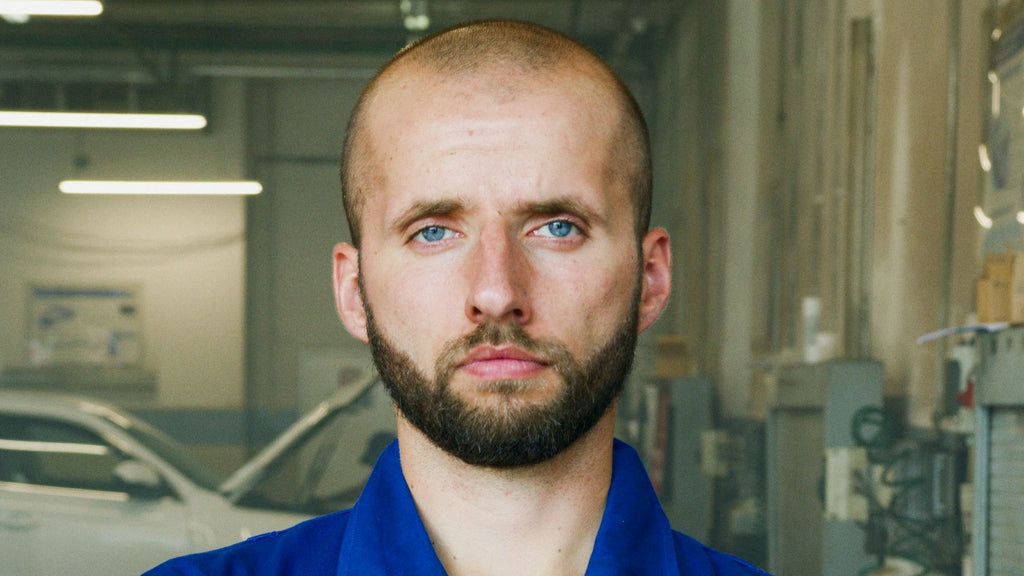Temple balding is disastrous for your self-image. And you deserve to be the best version of yourself, always.
The goal of this article is first to educate you on what it is, the next is to make sure you're oozing with confidence once you apply these solutions.
Summary:
- Can you really fix temple hair loss? (hint: good news)
- What are the natural and medical treatments for temple balding? (hint: more good news, including one of the best remedies)
- What is temple balding?
- Why does hair loss start at the temples?
- What are the signs of temple hair loss?
- What causes temple balding?
- Will hair ever grow back on your temples?
- Conclusion
Table of content
Can You Treat Temple Hair Loss?
Yes, hair loss at the temples can be treated, and depending on the stage of balding, it can be reversed as well.
Treatment options can potentially regrow hair in the thinning or balding areas near the temples.
A multipurpose approach, which involves a combination of various topical and oral medications, is usually recommended to treat hair loss caused by androgenic alopecia (the leading cause of temple baldness).
As your leading source for hair health information over the past 4 years, we never compromise on accuracy. When it comes to your health, you deserve information you can truly rely on - and earning your trust is our top priority.
Here's how Scandinavian Biolabs ensures every piece of content meets the highest standards of accuracy and integrity:
- Credentialed Experts: Our reviewers are actively practicing doctors and medical researchers
- Stringent Reviews: Content undergoes rigorous editing by subject specialists and review by a practicing doctor.
- Evidence-Based: We rely on well-established research from trusted scientific sources like peer-reviewed journals and health authorities.
- Full Transparency: Our editorial standards, writer credentials, reviewer credentials, correction process, and funding are all publicly documented.
- Independent Voice: While we do promote products, we operate in a vacuum to business operations. Our main goal is just an unwavering commitment to providing medically-sound guidance.
You can count on Scandinavian Biolabs to consistently deliver the trustworthy health information you deserve. Read our Editorial Standards.
What Treatments Are There for Temple Balding?

Following treatments are available to treat and/or help temple baldness in both men and women:
Natural or naturally-derived remedies:
- Hair growth product with 97% effectiveness
- Saw palmetto
- Rosemary oil
- Pumpkin seed oil
- 3% peppermint oil
- Caffeine
- Onion juice
- Green tea extract
Medical treatments:
- Finasteride
- Minoxidil
- Platelet-rich plasma treatment
- Low-level laser therapy
- Hair transplant
1. Scandinavian Biolabs Hair Growth Routine
These products (Hair Strength Shampoo, Hair Recovery Conditioner, and Bio-Pilixin Activation Serum) contain plant growth factors such as Capilia Longa, derived from stem cell technology that can help reduce hair loss, promote regrowth, and enhance hair density.
It's not all gibberish. To back it up, we'll refund you 100% if our products are ineffective after 150 days. We even have a page for it, here - Money-Back Guarantee.
2. Finasteride
This drug is used commonly for male pattern baldness and works by blocking the amount of dihydrotestosterone (DHT) in the scalp.
3. Minoxidil
A topical medication used to widen the hair follicle and extend the anagen or growth phase of hair. However, to maintain regrowth, minoxidil has to be applied indefinitely.
4. Platelet-rich plasma treatment
PRP is a noninvasive treatment in which the platelets extracted from the patient are then injected into the scalp to stimulate hair growth.
5. Low-level laser therapy
This procedure uses lasers to stimulate new hair growth by increasing blood flow in the scalp. It also prevents the excessive buildup of DHT in the hair follicles.
6. Hair transplant
Hair transplant is a surgical technique that involves moving the healthy hairs on the scalp (donor site) to thinning or balding areas (recipient site).
What is temple balding?
Temple balding is a gradual loss of hair in the temporofrontal region of the scalp. It progresses over the years and may increase in severity, depending upon the cause. It starts as thinning across the scalp, and then the temple region begins to bald.
Although temple balding is a common woe in many adult men with male pattern baldness or androgenic alopecia, women and young adults are susceptible to it as well. It's essential to identify this condition as soon as possible and start treatment accordingly.
Why does hair loss start at the temples?

To better understand hair loss you need to know about the hair growth stages;
Anagen
It is the growth phase. On average, about 80 to 85 percent of the hair on our scalp stays in this phase for around 2 to 6 years. Hair length depends on how long this phase lasts.
Catagen
The hair follicle renews itself in this two weeks long phase.
Telogen
This is the resting phase in which the hair follicle lies dormant. Around 12 to 20 percent of hairs are in this phase. After the hair growth cycle is completed, anagen starts again and the existing hair strand sheds to make space for new growth in the hair follicle.
The most common reason for balding near the temples is associated with the male hormone, testosterone (present in small amounts in women). The cells in our scalp convert testosterone into dihydrotestosterone (DHT). The follicles near the temple region become more sensitive to DHT due to a genetic predisposition or mechanical tension, which causes the hair follicles to shrink.
So naturally, you'd want to remove DHT from scalp, right? We have a guide on that here, too!
Hair loss occurs when the anagen phase becomes shorter, and the telogen phase extends due to this miniaturization of the hair follicles. Eventually, the anagen phase becomes so short that the new hairs stop growing out of the scalp's surface leading to baldness.
What Are the Signs of Temple Hair Loss?

You should look out for the following signs of early balding if you suspect hair loss at the temples:
- Decrease in overall hair volume
- Itching or irritation of the temporofrontal scalp region
- Brittle or weak hair
- Increased hair fall
- Visibly thinning hair (scalp showing through in the temple area)
- Hairline receding in a v-shape near the temples or a widow’s peak
What Causes Temple Balding?
There are a variety of conditions and behaviors that can cause balding near the temples. Some of the common causes for temple balding are given below;
Androgenetic Alopecia
In males, androgenic alopecia or male pattern baldness is the most common reason for temple balding. It occurs as part of the natural aging process, but some men begin to develop it in their early teens or early twenties.
This condition runs in families and is directly related to the male sex hormones (androgens). It starts as thinning on the crown and temples and eventually a receding hairline in an M-shaped pattern. As explained above, in this type of hair loss, the hair follicles shrink near the temples and crown, leading to partial or complete baldness.
Female pattern baldness is a condition affecting women that can cause hair thinning, widening of hair-part, and hair loss at the temples. Unlike male pattern baldness, women don’t suffer from a receding hairline or complete baldness. But, female have different hairlines. Due to the prominent role of hormones in female pattern baldness, menopause and polycystic ovary syndrome can also lead to this condition.
Frontal Fibrosing Alopecia
It is a form of lichen planopilaris that involves progressive hair loss and scarring near the frontal scalp hair margin and, in some cases, other parts of the body as well. Itching and pain are the early symptoms in frontal fibrosing alopecia and occur before any noticeable hair loss. The exact cause of this condition is still unclear.

Traction Alopecia
People who tie their hair in tight braids or wear hats can cause mechanical pulling on the scalp, which can lead to bald spots in different areas, including the temples. This is known as traction alopecia. If it is diagnosed early, precaution can be taken by ceasing the hair-pulling; therefore, traction alopecia is reversible, and hair regrowth is possible.
Telogen effluvium
Telogen effluvium is an abrupt and excessive hair loss due to stress in which the hair roots go prematurely into the resting or telogen phase. It usually causes diffused hair loss but thinning around the temples is also observed. Following are some of the reasons behind this condition;
- Hormonal imbalance
- Nutritional deficiencies (Iron, Zinc, Vitamin D, and B complex)
- Use of certain medications such as antihypertensives, antidepressants, and birth control pills.
- Childbirth
- Physical trauma such as surgery
- High-stress levels
- Fever
This condition resolves entirely on its own after six months, when the root cause is addressed.
Will your hair grow back on the temples?
The possibility of hair regrowth on the temples is dependent on the underlying cause and severity of the situation. Hair loss due to traction alopecia and telogen effluvium can be reversed and regrowth is achieved in a few months.
On the other hand, temple balding due to alopecia cannot be completely reversed. However, with early diagnosis and intervention hair loss can be slowed down.
Conclusion

Temple balding can be a nerve-wracking issue for many men and women. It can be caused by many conditions ranging from hormonal to behavioral to emotional behavior, but with timely diagnosis and treatment, the process of hair loss can be slowed and possibly reversed.
It's essential to get your condition identified with the help of a professional, who can guide you towards a suitable treatment plan.
Read more:
- Adderall and Hair Loss: What Do I Do If Adderall Ruined My Hair?
- Finasteride Is Not Working: What To Do?
- Hair Serum For Men: A Simple Guide
References
- Phillips TG, Slomiany WP, Allison R. Hair Loss: Common Causes and Treatment. Am Fam Physician. 2017 Sep 15;96(6):371–8.
- Kerkemeyer KLS, Eisman S, Bhoyrul B, Pinczewski J, Sinclair RD. Frontal fibrosing alopecia. Clin Dermatol. 2021 Mar;39(2):183–93.
- Low dose laser therapy for hair loss [Internet]. [cited 2021 Oct 9]. Available from: https://dermnetnz.org/topics/low-dose-laser-therapy-for-hair-loss
- Hair Growth Routine [Internet]. [cited 2021 Oct 9]. Available from: https://scandinavianbiolabs.com/collections/hair-growth-products-for-men/products/hair-growth-routine-for-men







